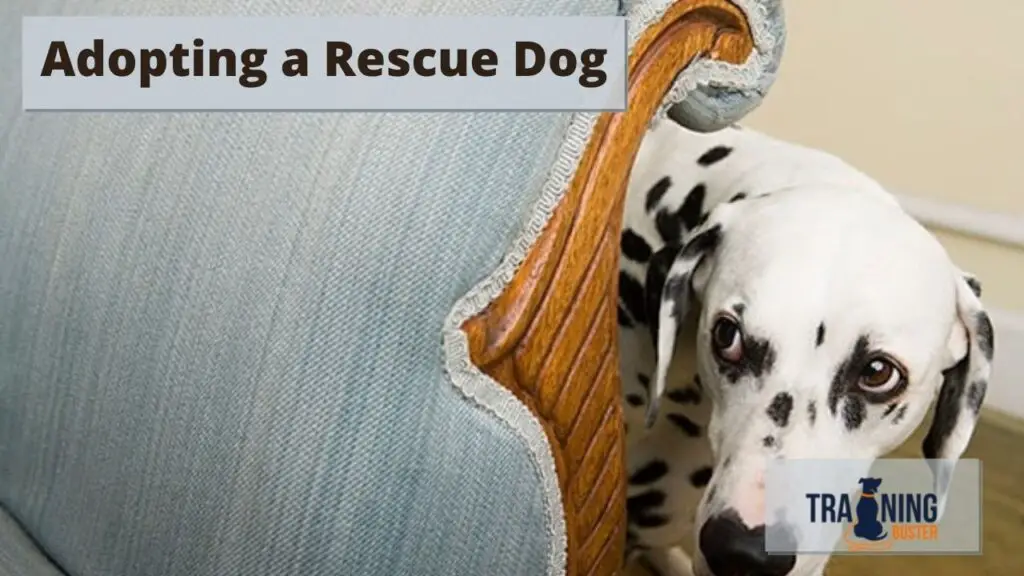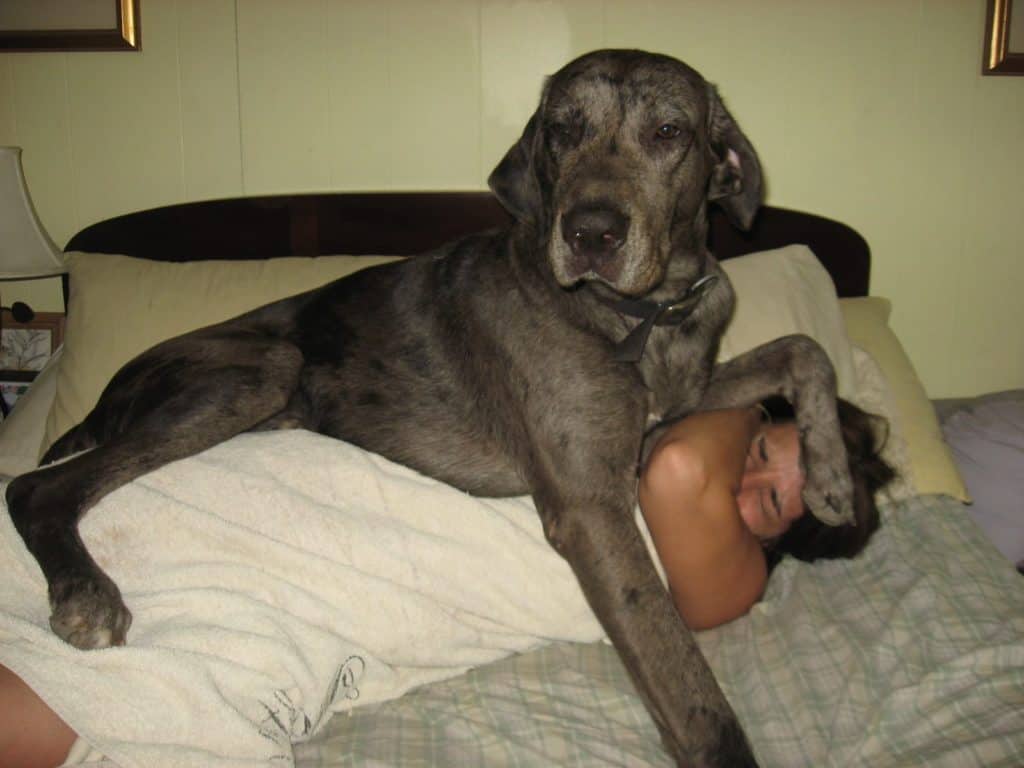
If you are looking for things to know when adopting a dog as a new pet you are in the right place.
The quick answer is:
- Relieve Stress.
- Feeding your dog.
- Getting a dog to create.
- Toilet training.
- Create training.
- House training.
- Look for behavioral issues.
- Looking for aggression.
- Things to keep in mind.
Adopting a pet from a shelter can be a rewarding experience that provides a disadvantaged canine a much-needed home and a companion that is faithful and loyal to their new parent’s families. But because they come from circumstances that have left them with physical or behavioral issues, they will need help in order for them to live happy, healthy lives.
Employees and volunteers at organizations and shelters try their best to work with an incoming pet to gauge any issues that they might have. But with overcrowding and limited funding there frequently isn’t sufficient opportunity for the evaluation of incoming pets.
It often falls on the individuals who adopt a new pet to give them the help they need. Learn how to be a great dog trainer here.
Things to Know When Adopting a Rescue Dog
- Determine where your new friend will be spending most of his time. Because he will be under a lot of stress with the change of environment (from a shelter or foster to your house), he may forget any housebreaking (if any) he’s learned. Often a kitchen will work best for easy clean-up.
- If you plan on a crate be sure to have a crate set-up and ready to go for when you bring your new friend home. Find out more about crate training.
- Proof the area where your pooch will spend most of his time during the first few months. This may mean taping loose electrical cords to baseboards; storing household chemicals on high shelves; removing plants, rugs, and breakables; setting up the crate, and installing baby gates.
- Training will start the first moment you have him. Take time to create a vocabulary list everyone will use when giving your dog directions. This will help prevent confusion and help him learn his commands more quickly.
- Bring an ID tag with your phone number on it, and chew toys with you when you pick up your new pet so that he has an extra measure of safety for the ride and the first few uneasy days. If he is microchipped, be sure to register your contact information with the chip’s company, if the shelter did not already do so.
Your first day with your new dog
![]() Relieve your dog’s stress
Relieve your dog’s stress
We know moving is stressful — and your new re dog feels the same way! Give him time to acclimate to your home and family before introducing him to strangers. Make sure children know how to approach them without overwhelming them.
Feeding your new dog
When you pick up your new rescue dog from the rescue groups, remember to ask what and when he was fed, and if he has any favorite food.
Replicate that schedule for at least the first few days to avoid gastric distress. If you wish to switch to a different brand, do so over a period of about a week by adding one part of new food to three parts of the old for several days; then switch to half new food, half old, and then one part old to three parts new.
Getting a create
On the way home from an animal rescue group, your new family member should be safely secured, preferably in a crate that has had some puppy proofing. Some find car trips stressful, so a great way is to have him in a safe place will make the trip easier for him and you.
You can find many different creates on Chewy. Here is my favorite

Toilet training a rescue dog
Once home, take him to his toileting area immediately and spend a good amount of time with him so he will get used to the area and relieve himself. Even if your best friend does relieve himself during this time, be prepared for accidents.
Coming into a new home with new people, new smells and new sounds can throw even the most housebroken pets off-track, so be ready just in case. For more information, I have written a more in-depth guide here.
Pick a potty spot for your rescue dog
The first step to house training your dog is to potty-train him. To do this, take your dog or pup out to the exact same spot every day at the same time for him to relieve himself.
It might be a little taxing at first but with positive reinforcements, it should not be very difficult for your dog to understand and adapt. Make sure to praise your dog if he does his training right by either words or a treat so that he understands you want him to do it.
Dogs usually recognize their place of excretion by the smell of it and by the third or fourth time, your dog should be able to go on his own.
Keep a consistent schedule when dog training
The key to pet ownership successfully is consistency in his schedule. Make a mental note of when to take him outside. Ideally, he should be taken to his spot right after he wakes up in the morning. After that, every other hour and twenty minutes after his meals should be fine. You need to also take him before going to bed.
Create training your new rescue dog
If you plan on creating your adopted dog, leave the crate open so that he can go in whenever he feels like it in case he gets overwhelmed. From there, start your schedule of feeding, toileting, and play/exercise.
From Day One, they will need family time and brief periods of solitary confinement. Don’t give in and comfort him if he whines when left alone. Instead, give him attention for good behavior, such as chewing on a chew toy or resting quietly.
- For the first few days, remain calm and quiet, limiting too much excitement (such as the park or neighborhood children). Not only will this allow your doggy to settle in easier, but it will also give you more one-on-one time to get to know him and his likes/dislikes.
If he came from another home, objects like leashes, hands, rolled up newspapers and magazines, feet, chairs, and sticks are just some of the pieces of “equipment” that may have been used on this rescue pet
Words like “come here” and “lie down” may bring forth a reaction other than the one you expect. Or maybe he led a sheltered life and was never socialized to children or sidewalk activity.
This dog may be the product of a never-ending series of scrambled communications and unreal expectations that will require patience on your part.
What’s the most important thing to keep in mind when house training my rescue dog?
House training requires a number of essential things to be done correctly. But the most significant one is patience. If you can maintain patience, then it’s more likely that you will be able to handle other important things, like keeping a consistent schedule, positive reinforcement, and persistent supervision.
Are there any significant differences between house training a puppy and house training an older dog who has been rescued or rehomed? If he isn’t house trained, and it isn’t due to a medical or behavioral issue, then the process is just the same as house train a puppy.
It could be even much easier to house train an adult as they have more control over their bladder, and they are more trainable.
Health concerns for rescue dogs
Diarrhea: Many animal shelter dogs experience diarrhea for a brief time. A rescue dog has often experienced extreme periods of stress up to and including the time that they spent in the shelter or a facility.
Changes in diet can also contribute to bouts of diarrhea, and this may continue to be an issue once you have brought your new friend to a home environment. Check with the shelter about the type of food they have been feeding.
If you intend to offer different food, do so gradually. Start by mixing a small amount of new food in with the food that your pooch is currently eating, then slowly increase the amount over several days to allow your dog’s stomach to adjust with a minimal amount of upset.
If food doesn’t seem to be an issue, diarrhea could simply be brought on by stress. Even in their new home with loving owners, new dogs are likely to be nervous and stressed in the beginning, which can result in an upset stomach. Be patient and try not to scold.
Take your furry companion out frequently, ensure they get a good amount of exercise to release nervous energy, and fresh water is always available to prevent dehydration, and keep the energy level up.
If diarrhea doesn’t seem to clear up, or if your dog is showing other signs of illness, be sure to take them to your veterinarian.
Malnutrition: Often, rescue dogs come from dire circumstances that may have prevented them from receiving regular meals. Malnourishment can cause numerous health issues, and it isn’t an issue that can be repaired overnight.
If you feel that your rescue dog is malnourished, have them checked over by a veterinarian to check if there is no permanent damage. If your dog is especially thin, it’s best to feed them small amounts several times a day rather than one or two larger meals.
This will help them to retain more nutrition and will prevent damage that could be caused if your dog eats a large meal too fast.
Behavioral issues in rescue dogs and how to address them
Behavioral issues in rescue dogs are much harder to diagnose and address than the physical ailments they might experience. Often, rescue dogs come to the shelter with problems that can’t be traced to a particular trigger or situation.
While personnel does their best to work with them to alleviate these issues, it is often a long-term project that requires a lot of love, patience, and attention. The following are some of the more common rescue behavioral problems, with pointers on how to handle them.
Fear and anxiety in rescue dogs: And how to calm them down
Many rescue dogs experience high levels of fear and anxiety when they first come home from the shelter. They’ve gone from the circumstances that brought them to the shelter or rescue facility, to shelter life, then into a home with individuals they don’t know and surroundings they’re unfamiliar with.
Many dog’s anxiety issues stem from uncertainty. It’s important to be extremely patient and gentle during this transition. Remember that your new friend doesn’t know you yet, and has been through a troubling time.
Watch for signs of anxiety such as cowering and hiding. Though it may be your first inclination to want to love and cuddle your new friend, give her some space, and allow her to approach you in her own time.
Place water in a quiet place. If your dog seems anxious, speak in a soft, reassuring voice, and minimize sudden movements. Make sure to take her for long walks and encourage a lot of playtimes to burn off nervous energy and strengthen your bond with your dog.
More often than not, anxiety will diminish over time, once they have adjusted to their new surroundings. Aggression in rescue dogs needs to be treated right away
A new dog can exhibit aggression in a variety of ways. It may be directed towards your other pets, toys, hats, uniforms – the list could just keep going. Shelter personnel does their best to evaluate dogs for aggression issues before placing them for adoption. But they only have so much time with each individual, and aggressive signs might be missed.
Aggression can be very dangerous. If you feel that you’re not properly equipped to handle a dog with aggression issues, contact a professional who specializes in rescue behavior training. Even if the aggression being presented is relatively mild, training is a good idea when dealing with a rescue dog.
Consider enrolling your dog in a basic obedience class that you can attend with him. This will strengthen your bond with your dog, and give you the tools needed to address any issues that arise down the road.
Most obedience classes consist of small groups of owners and their dogs. If your dog has aggression issues toward other animals, be sure and let the trainer know before attending a class.
It may be necessary to arrange for one on one lessons to prevent any injuries from occurring due to dog fights.
House training rescue dogs is possible
It is not uncommon for dogs to initially have problems with inappropriate elimination in your home. With a little patience and understanding, this problem can often be corrected, especially if you understand why your dog is exhibiting this behavior.
There are several reasons why a dog will eliminate in the house. With puppies and even some adult dogs, it’s just a matter of teaching them where it is appropriate to relieve themselves.
With a little diligence, these guys can be house-trained in a relatively short time span. There may also be behavioral issues behind inappropriate elimination.
Submissive urination occurs when a dog is feeling excited or fearful. Care has to be taken not to scold these dogs for their accidents, because it can make the situation worse. Instead, pay attention to what is causing your dog’s submissive urination and address the issue in a calm and gentle manner.
Separation anxiety can also be the reason behind inappropriate elimination. Many dogs feel particularly anxious when they are left alone, resulting in accidents in the house. If possible, take your new friend on a long walk before leaving, and include some playtime to burn off excess energy.
This will give your dog the opportunity to relieve themselves, and the exercise will help calm them down and tire them out so they are more likely to relax after going back inside. If you can’t determine any particular reason why your dog is relieving herself, take her to your veterinarian for a check-up to make sure there are no health issues that are causing the behavior.
Destructive Behavior in Rescue Dogs Has a Solution
Destructive behaviors such as chewing, shredding, and digging are all generally related to separation anxiety or excessive amounts of energy. Dogs often resort to destructive behaviors because they are anxious about something or they’re bored.
This behavior is their way of alerting you to the fact that something is bothering them. Reprimanding dogs who exhibit this behavior is not a solution and can actually make it worse.
Instead, make sure that your dog has plenty of exercises and provide her with toys that will engage her mind. Some dogs have a difficult time socializing with people or other animals.
This is often due to how they were treated before they were taken in by the shelter. They may have been mistreated, or if they were strays, they may have had issues with other animals and dominance over food and shelter.
Socializing issues could also be the result of a lack of exposure to other people or animals by their original owners.
Regardless of the reasons, it’s important to socialize with your friend to ensure that they get along with new people and are able to adapt to new situations. Some dogs do well with exposure therapy, while others respond more positively to a gradual approach that gives them a chance to slowly acclimate to new people and situations.
Things to keep in mind with a rescue dog
The important thing to keep in mind is that your dog is also capable of love but it has trust issues because of its rough past. It is as capable of love and emotions as any other puppy you might adopt from a breeder but since they have suffered trauma, it is difficult for them to suddenly trust you.
Put yourself in their shoes: if the same were to happen to you, would you not be a little suspicious at first? The key here is time. You see, the doggy doesn’t know you ‘saved’ him. He has no concept of it. And thus, he doesn’t really appreciate the quantum of your care for him yet.
But with enough time and with positive reinforcements, he will slowly start to learn to trust again and will find you to be the most amazing owner who cares for him, feeds him, and takes care of all his needs. And eventually, he will have turned the page on his past life and embrace this new wonderful second chance.
Most pooches take about three months to acclimatize themselves to the new environment and to you. If it has been more than that and your dog still seems stressed out or are depresses/scared/nervous, there might be a behavioral problem that you would need to fix.
In that case, it is best advised to take him to a behavior specialist who will access him and tell you what exactly needs to be done. Rescues often also come with a plethora of health issues that may or may not be disclosed to you at the time of adoption.
Therefore it is best to first have the dog get examined by a vet before deciding if you want to keep him. Diseases in dogs can be quite varied from dental problems to cancer and therefore you must have a considerable budget if such a situation arose.
Therefore preparation needs to be taken if you decide to go ahead and adopt a dog with health issues. Medicine is quite expensive and can be quite stressful for you.
To tackle that, you might want to look into pet health insurance. Pet insurances are similar to their human counterparts and cater to offset the expenditure of medical care.
Maximizing your chances of success with a new dog
Before you begin training, you must keep in mind that each dog is different and that there is no universal manual when it comes to training your dog. A lot of it is dependent on the bond that you two share and also on how quickly can the dog read your signals. Here are some helpful tips on what you can do to maximize your chances of success:
Be patient
Every dog learns in its own sweet time. Do not rush him. It might affect him inversely and may consequently hamper the training. Give him clear signals and praise him when he does it right. It may not happen overnight but with sufficient practice, your dog will learn to adapt.
If your dog is having trouble with any portion of being house trained, be sure that you are giving him clear indications of what he needs to do. If you are and he is still confused, maybe you need to look into alternative approaches to tackle the problem.
Watch for incontinency
It is quite common for dogs to suffer from incontinence and you must lookout for any such indication in your dog.
If in spite of the training, your dog often relieves himself indoors or wets himself while sleeping, he might suffer from incontinency. If that is the case, schedule a visit to the vet to figure out the medical problem.
Give your dog your time
Training a dog is taxing. It takes time and constant vigilance in the first few weeks. It may be hard for you to manage training him while you are working 9-5 shifts so it is best that you take some time off to train them properly.
be sure they get plenty of exercise to check out my article dog training gear for the backyard. Accidents during training are common and must be tended to immediately. Also, since he is just learning to relieve himself outside, he must have someone at all times to let him out should he need to go.
Not allowing that may make him go back to his old spot indoors thus negating the training. If you cannot get time off and need to be at work, see if a friend would help. If you found someone to look after your dog when you are gone, be sure to walk them through the entire training so that it is consistent.
You might also consider hiring a pet sitter.
Related questions
I am looking to adopt from the shelter. What breed should I choose?
Look for a dog that compliments your lifestyle — not just one that’s calendar-worthy, cute, or the right size. People often pay attention to the breed because of physical features or because it is the breed they grew up with.
Potential adopters should be looking at other characteristics, too. Some dogs require a lot of exercises and mental stimulation, while others might like to lay around or are most content sitting on your lap.
And some dogs might even experience anxiety in large crowds or public places. Finding a dog that matches your activity levels and preferences is critical in having a successful relationship later on.
I really want to adopt but don’t know if my landlord would let me keep it. What should I do if he doesn’t?
Adopting any pet is a life-long commitment. That means you commit to keeping the animal for its entire life and making it part of your family, and you consider all the changes that may happen during the next 15 years or so, and make sure you will keep your dog through those changes.
Some reasons people cite for giving up their dogs are:
- I’m moving to a place that won’t allow dogs
- I’m getting married and my spouse doesn’t want a pet
- I’m pregnant and no longer want the extra work of having a dog, or don’t know how the dog will react to my baby
- He is old, and I want one that’s young
- He is sick, and I can’t afford her vet bills
If you think you may give up for any of the reasons above, then DON’T gets one. Even if you are having trouble affording veterinary bills at some point, if you love the animal, you’ll find a way to care for them.There are groups that can help (we have programs to help such people), and if you love them, you’ll make it happen.
In summary, don’t get a pet unless you’ll really love them.


